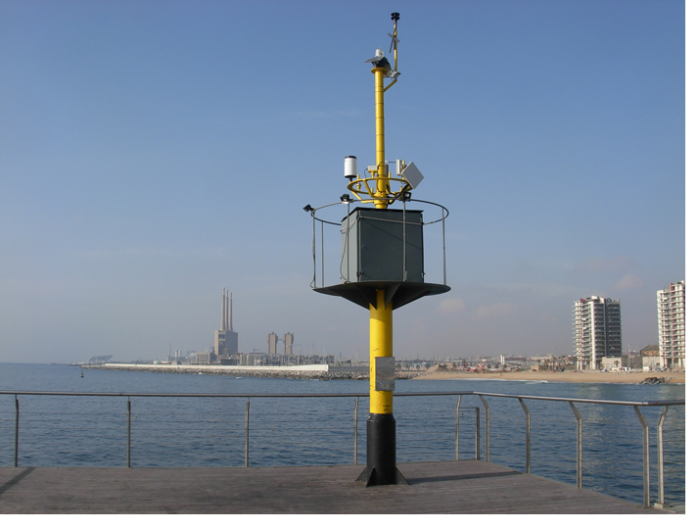
ポン デル ペトロリは、タンカーから陸上への石油の移送を可能にするために 1960 年代に建設されました。桟橋はバルセロナに近いバダロナの砂浜付近の海上に約 250 メートル伸びています。プラットフォームは平均水面より 6 メートル上にあり、水深は最も深いところで 12 メートルです。
石油桟橋は 1990 年に産業用途から外れました。2001 年には、解体を避けて公共用途に再利用するよう国民から要望がありました。2002 年に LIM-UPC は桟橋を科学ステーションとして使用することを提案しました。2003 年に桟橋はバダロナ市議会に引き渡され、2009 年に市議会は桟橋を公共のレジャー施設に再利用する作業を開始しました。
これらの作業を利用して、LIM-UPC は、桟橋を海と大気の監視の科学的拠点として使用するための一連のシステムを設計、統合、および設置しました。このため、桟橋は現在、カタルーニャ海岸で唯一の沿岸ステーションであり、スペイン東海岸ではユニークで、地中海では非常にまれです。重要な点は、ステーションがブイから伝播された波データを沿岸測定に関連付けることができるだけでなく、地上の影響を受けずに海岸近くで海上の気象データと外洋での潮汐測定を提供できることです。
桟橋には、海や天候の状態を測定するための一連の機器が装備されており、将来の研究の情報源としてだけでなく、桟橋の近くで実行できる実験作業の境界条件としても役立ちます。これは、気候変動、代替エネルギー、沿岸のダイナミクスなどに関連する科学的研究のプラットフォームとして機能します。さらに、機器の設計では、データの一般利用を考慮し、近くのビーチの利用者のために、海の状態 (波と流れ)、水質、大気パラメータ (快適な温度レベル、推奨される日焼け止めなど) を強調しています。
機器の設置と同時に、杭には配線が完全に施され、各杭に接続ポイントが設けられ、追加の固定式または一時式測定装置を簡単に設置できるようになりました。
桟橋の最も深い部分の上にある高さ 7 メートルの塔に測定ステーションがあります。ステーションの中心には Campbell Scientific CR1000 データロガーが設置されており、すべてのセンサー データを収集します。
気象センサーには、気温と湿度を測定する HMP45C、大気圧を提供する CS100、総太陽放射量を測定する LP02、降水量を測定する RM Young 52200 が含まれます。突風、風速、風向は、Gill Instrument Windsonic 風速計によって提供されます。
海洋センサーには、海面レベル、およびいくつかの計算による有意波高と最大波高、ピーク周期、および方向を提供する 2 つのレーダー水位センサーが含まれます。Nortek Aquadopp 流速計は流速と方向を提供し、SBE-MicroCAT レコーダーは水温と塩分データを提供します。これら 2 つのセンサーは、深さ 5 m の海底構造物に設置されています。
気象および海洋データはデータロガーによって 10 分ごとに平均化され、1 km の Wi-Fi リンクを使用して LoggerNet ソフトウェアによって制御される受信 PC に送信されます。2 つの海面レーダー ゲージからの 1 Hz の海面生データが 20 分間送信され、波のスペクトルと統計の計算に使用されます。
取得されたすべてのデータは無料のウェブ サービスにアップロードされ、ウェブカメラの画像を含むバダロナ ビーチの海と天気の状況を住民がリアルタイムで知ることができます。さらに、すべてのデータは科学的目的のために浄化され、保存されます。
ポント デル ペトロリ桟橋は、海洋測定を行える独自性と柔軟性により、堆積物輸送の研究から新しい測定機器や技術の開発まで、さまざまな目標を持つ多くの研究プロジェクトで使用されてきました。